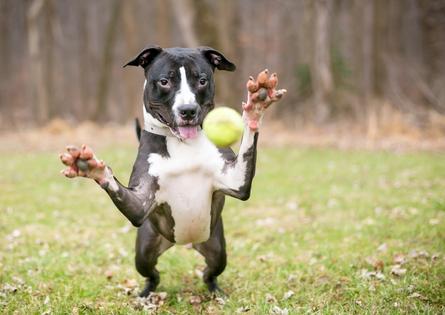Pet World: 'Kangaroo pup' just needs a little obedience work
Dear Cathy,
I have a very happy and sensitive 13-1/2-pound, long-legged poodle puppy. She’s so excited when she sees other people that she jumps as high as my shoulders and sometimes the leash wraps around her legs and she falls hard on her back. I’ve tried commands, treating, and very short leashes but nothing has worked. I’ve considered a training buzz collar. Would you recommend this?
–Lorraine, Wethersfield Connecticut
Dear Lorraine,
Nix the buzz collar. Basic obedience training will help your “kangaroo puppy” keep all four paws on the ground. Get a “clicker” from a pet store and teach your dog her name. Say her name, and every time she looks at you “click” the clicker and give her a treat. Do this name training 25 times in each session, twice a day.
Next, using the same technique, teach her to “sit,” “stay,” “down” and “come” when called. When you ask her to sit and she sits, click the clicker, and give her a treat. The clicker marks the desired behavior when it occurs. Train her on all these commands until she is doing these things quickly and easily. (You also can use a reward word, like bingo, in place of the clicker to mark the behavior and then give her a treat. But because clickers make a clear and concise noise, they often speed up learning.)
Now you are ready to train her to stop jumping. When she jumps for any reason, ask her to sit. She will struggle with the decision, but if she is trained well to sit, she should start to sit. When you see her start to go into a sit position, click the clicker, but wait until she is actually in the sit position before giving her the treat.
If she doesn’t sit, then turn your back on her when she jumps. When you are no longer paying attention to her, she will likely drop to all fours. The moment she drops, click the clicker and give her a treat. You are rewarding her for keeping all four paws on the ground. When she gets the hang of it, pair the new behavior with a training word like “off.” Use the word “off” like you would “sit” in asking her to not jump. When her four paws hit the ground, click the clicker and give her a treat.
Be consistent with training, and she will learn to stop jumping.
Dear Cathy,
I read about the Yorkipoo that was relieving herself in the house even after being outside for a long walk and want to offer two housetraining tips.
First, when there is an accident in the house, wipe it up with a paper towel. Then place the paper towel in the designated relief area with a rock on top of it to keep it from blowing away. This puts the scent right where you want the dog to go, which is extremely helpful in training.
Second, verify your cleaner does not contain ammonia, which mimics the smell in urine. If you are spreading a urine smell on the floor, they won’t understand the concept of peeing elsewhere. Dogs have amazing noses. By using olfactory clues, they can more easily succeed.
–Angie, St. John, Indiana
Dear Angie,
The ammonia tip is spot on. Cleaners with ammonia draw dogs and cats right back to the spot. Always use enzymatic cleaners to completely remove all traces of urine and fecal matter.
The tip on the rock and paper towel is new to me, but I don’t discount anything if it does no harm and works. It seems similar to using a training pee pad, which is used to teach a dog to go in a designated area in the house. If one is training a dog to relieve himself outside though, then removing all accidents with an enzymatic cleaner will help move that process along.
Thanks for sharing your tips.
Dear Cathy,
I saw the query about natural flea remedies. If you’re not familiar with Vet's Best spray, please look into it. It doesn't just kill fleas. I killed a wasp with it! I also spray it on myself against mosquitoes and my clothes against ticks. It smells great too.
–Sharyn, Simsbury, Connecticut
Dear Sharyn,
I actually use Vet’s Best Flea and Tick Spray on a cat (who I walk in the backyard on a leash). It is natural and does require repeat applications to be effective. But it is another way to ensure a pet is free from parasites.
========
(Cathy M. Rosenthal is a longtime animal advocate, author, columnist and pet expert who has more than 25 years in the animal welfare field. Send your pet questions, stories and tips to cathy@petpundit.com. Please include your name, city, and state. You can follow her @cathymrosenthal.)
©2020 Tribune Content Agency, LLC.
(c) 2020 DISTRIBUTED BY TRIBUNE MEDIA SERVICES, INC.










